Trane Technologies Bundle
How does Trane Technologies dominate the HVAC industry?
Trane Technologies, a global leader in climate innovation, has evolved significantly since its inception. From its roots in plumbing to its current status as a multi-billion dollar enterprise, the company's journey reflects a commitment to sustainable solutions and market adaptation. This Trane Technologies SWOT Analysis provides a deeper look at its strategic positioning.
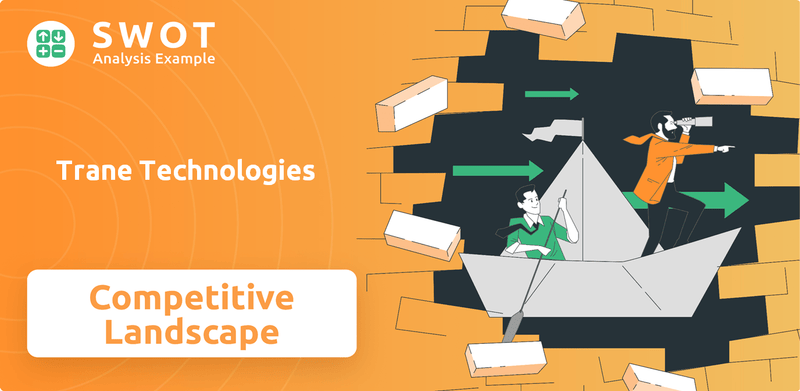
This exploration of Trane Technologies will delve into its competitive landscape, providing a comprehensive market analysis of its position within the HVAC industry. We will identify Trane Technologies' main competitors and analyze its competitive advantages, examining its financial performance and growth strategies. Furthermore, we will explore its global presence, innovation in HVAC technology, and future outlook, providing valuable insights for investors and industry professionals.
Where Does Trane Technologies’ Stand in the Current Market?
Trane Technologies is a major player in the global climate control industry, particularly in Heating, Ventilation, and Air Conditioning (HVAC) and transport refrigeration. The company's core operations involve designing, manufacturing, and servicing a wide range of HVAC systems and transport refrigeration units. They cater to commercial, residential, and industrial clients, as well as the transportation sector, offering solutions under brands like Thermo King.
The value proposition of Trane Technologies centers on providing energy-efficient and sustainable climate solutions. They focus on helping customers reduce their carbon footprint while improving operational efficiency. This includes offering integrated systems, smart building technologies, and comprehensive service and energy management solutions. This approach aligns with the growing demand for environmentally responsible and technologically advanced climate control systems.
Trane Technologies holds a strong market position in the HVAC industry. While specific market share data for 2024-2025 is not fully public, the company is consistently ranked among the top global leaders. They compete with major players like Carrier Global and Johnson Controls.
Trane Technologies has a significant global footprint. They operate across North America, Europe, the Middle East, Africa (EMEA), and the Asia Pacific region. This broad presence allows them to serve a diverse customer base worldwide and capitalize on regional market trends.
The company serves a wide array of customer segments. These include large commercial enterprises, industrial facilities, residential customers, and transportation companies. This diversification helps to mitigate risks and capture opportunities across various sectors.
Trane Technologies has strategically shifted its focus towards sustainable and digitally integrated solutions. This includes offering comprehensive service and energy management solutions. This shift aligns with global trends towards decarbonization and smart building technologies.
Financially, Trane Technologies reported revenues of $17.7 billion in 2023, demonstrating its substantial scale and financial health. The company's emphasis on sustainable solutions and services positions it favorably in regions and sectors prioritizing energy efficiency and environmental responsibility. For a deeper dive, you can explore a detailed Trane Technologies market analysis.
In 2023, Trane Technologies achieved revenues of $17.7 billion, underscoring its strong financial performance. The company's focus on sustainable solutions and services is a key driver of its financial success.
- Strong revenue figures reflect a robust market position.
- Emphasis on sustainable solutions is a key strategic advantage.
- Global presence supports diversified revenue streams.
- Financial health enables continued investment in innovation.
Trane Technologies SWOT Analysis
- Complete SWOT Breakdown
- Fully Customizable
- Editable in Excel & Word
- Professional Formatting
- Investor-Ready Format
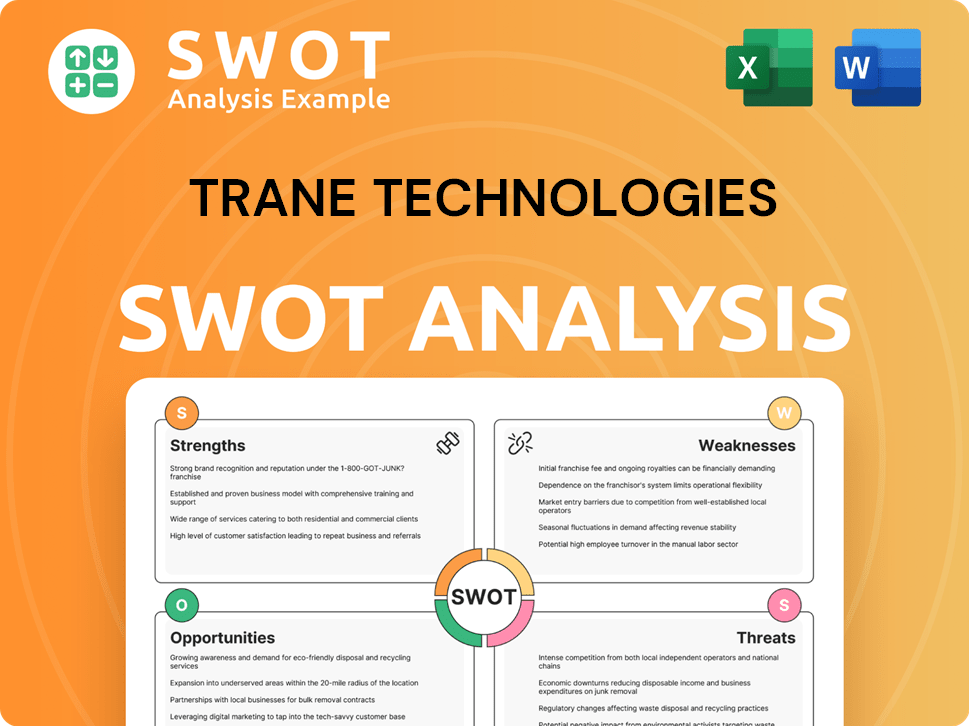
Who Are the Main Competitors Challenging Trane Technologies?
The Trane Technologies operates within a fiercely contested competitive landscape. The HVAC industry and related sectors are characterized by intense rivalry among established global players and specialized firms. Understanding the key competitors is crucial for a thorough market analysis and a comprehensive company overview.
Several factors contribute to the competitive dynamics, including price, technological innovation, brand recognition, distribution networks, and digital integration. The Trane Technologies faces challenges from various competitors across its diverse business segments, requiring strategic responses to maintain and enhance its market position.
Trane Technologies faces significant competition from several major players in the HVAC and related industries. These industry rivals challenge Trane Technologies on multiple fronts, including market share, technological innovation, and geographical reach. The competitive environment is dynamic, with ongoing developments in technology, mergers, and acquisitions constantly reshaping the landscape.
Carrier Global Corporation is a direct competitor, especially in HVAC and refrigeration. It offers a wide range of heating, air conditioning, and refrigeration solutions for residential, commercial, and transport applications. Carrier and Trane Technologies often compete directly for large commercial projects.
Johnson Controls competes in building technologies, including HVAC, building management systems, and fire and security solutions. It offers integrated solutions and services, posing a significant challenge to Trane Technologies, particularly in the commercial building sector. The company's focus on smart building technologies is a key differentiator.
Daikin Industries is a global leader, primarily in air conditioning systems, known for its technological advancements. It has a strong presence, particularly in Asian markets. Daikin's innovation in energy-efficient technologies and its strong brand recognition are key competitive strengths.
In the transport refrigeration segment, Thermo King faces competition from companies like Carrier Transicold. This segment is highly specialized, with a focus on temperature-controlled transport solutions. Competition is based on efficiency, reliability, and service capabilities.
Emerging players focus on niche markets, such as sustainable cooling technologies and smart building solutions. These companies often bring innovative approaches and technologies, challenging established players. The impact of mergers and alliances constantly reshapes competitive dynamics.
The industry sees constant changes, including technological advancements and market consolidation. Companies compete on price, innovation, and service. Understanding these dynamics is crucial for strategic planning. For more insights, see the Marketing Strategy of Trane Technologies.
Trane Technologies and its competitors focus on several key factors to gain an edge in the market. These factors include technological innovation, brand reputation, and service capabilities. The ability to offer integrated solutions and sustainable products is increasingly important.
- Innovation in Energy-Efficient Technologies: Developing and implementing energy-efficient HVAC and refrigeration systems is a critical competitive advantage.
- Brand Recognition and Reputation: Strong brand recognition and a positive reputation for quality and reliability are essential.
- Extensive Distribution Networks: A well-established distribution network ensures products reach customers efficiently.
- Advanced Digital Integration: The integration of smart technologies and digital solutions enhances product performance and customer experience.
- Service Capabilities: Providing comprehensive service and maintenance support is crucial for customer retention and satisfaction.
Trane Technologies PESTLE Analysis
- Covers All 6 PESTLE Categories
- No Research Needed – Save Hours of Work
- Built by Experts, Trusted by Consultants
- Instant Download, Ready to Use
- 100% Editable, Fully Customizable
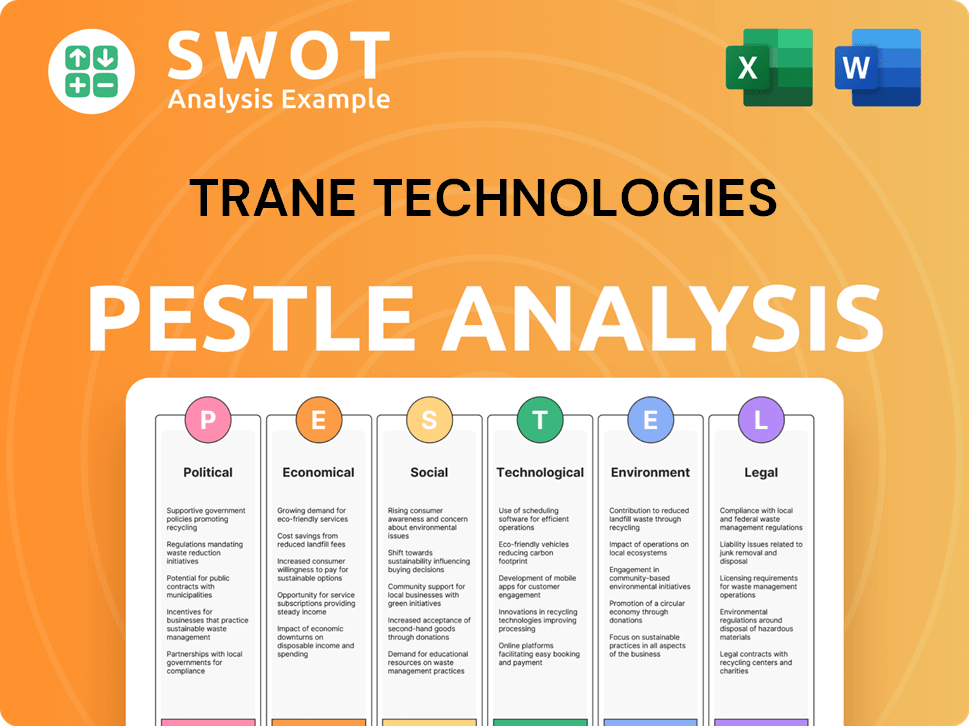
What Gives Trane Technologies a Competitive Edge Over Its Rivals?
Understanding the competitive landscape of Trane Technologies requires an examination of its key strengths and strategic positioning within the HVAC industry. The company, known for its Trane and Thermo King brands, has cultivated a strong reputation, which significantly influences its market share and customer loyalty. A comprehensive market analysis reveals how these advantages enable Trane Technologies to maintain a competitive edge against industry rivals.
Trane Technologies' success is built on a foundation of proprietary technologies and a global presence. Its focus on energy-efficient solutions and digital transformation has positioned it well for future growth. Examining its competitive advantages provides insights into how the company navigates challenges and capitalizes on opportunities within the dynamic HVAC market.
To gain a comprehensive understanding, it's essential to analyze the company's strategic moves, including recent acquisitions and mergers, and how these actions have shaped its competitive position. Furthermore, a deep dive into its product portfolio and financial performance compared to competitors offers a clearer picture of its market dynamics. For more details, you can read the Brief History of Trane Technologies.
Trane Technologies benefits from strong brand recognition, particularly through its Trane and Thermo King brands. This reputation is built on reliability and innovation. This brand strength directly impacts customer trust and loyalty, providing a significant competitive advantage in the HVAC industry.
The company holds proprietary technologies in energy-efficient HVAC systems and transport refrigeration. These innovations, including advanced compressor technologies, enhance performance and reduce environmental impact. Continuous investment in R&D is crucial for maintaining this competitive edge.
Trane Technologies has an extensive global distribution network and service capabilities. This network allows the company to reach a broad customer base and offer comprehensive post-sales support. This robust infrastructure fosters strong customer loyalty and facilitates market penetration.
Economies of scale in manufacturing and procurement contribute to Trane Technologies' competitive edge. This allows for cost efficiencies that can be passed on to customers or reinvested in research and development. These efficiencies enhance profitability and competitiveness.
Trane Technologies is strategically investing in digital transformation, developing smart building solutions and connected services. This includes remote monitoring, predictive maintenance, and optimized energy consumption. The company is also focusing on sustainability initiatives to attract environmentally conscious clients.
- Digital Solutions: Smart building solutions and connected services.
- Sustainability: Focus on environmentally friendly products and practices.
- Market Position: Drives innovation and enhances customer value.
- Financial Performance: In Q1 2024, the company reported revenue of $3.7 billion, a 6% increase year-over-year, driven by strong demand for its HVAC and transport refrigeration solutions.
Trane Technologies Business Model Canvas
- Complete 9-Block Business Model Canvas
- Effortlessly Communicate Your Business Strategy
- Investor-Ready BMC Format
- 100% Editable and Customizable
- Clear and Structured Layout
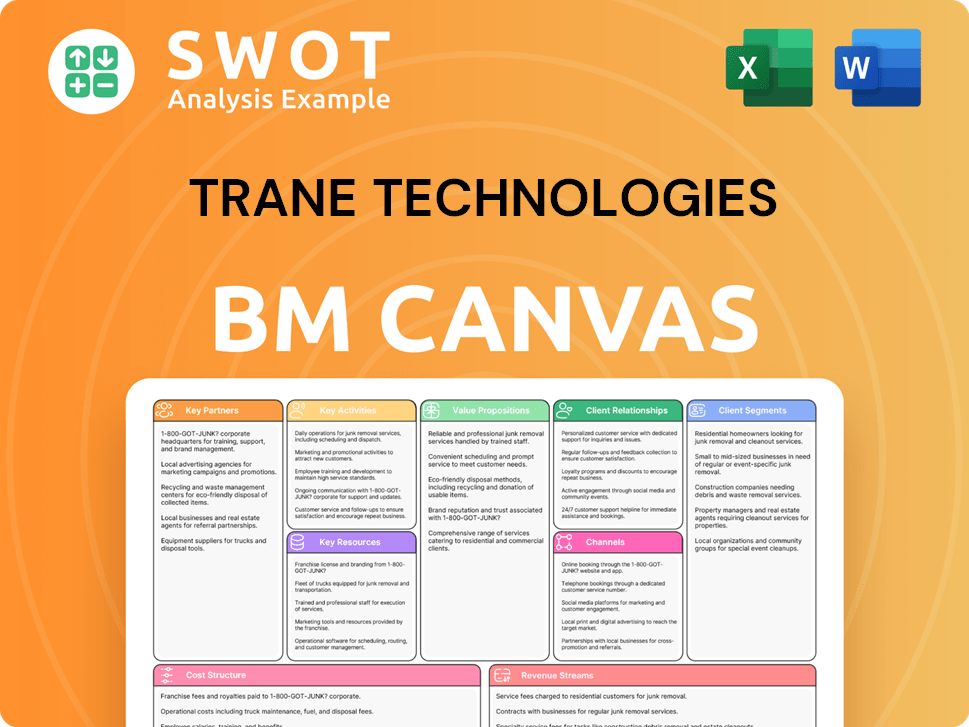
What Industry Trends Are Reshaping Trane Technologies’s Competitive Landscape?
The Target Market of Trane Technologies is significantly influenced by the dynamic shifts within the HVAC industry. These shifts are driven by technological advancements, regulatory changes, and evolving consumer preferences. A comprehensive market analysis reveals a landscape where innovation and sustainability are key drivers, shaping both opportunities and challenges for companies like Trane Technologies.
The competitive landscape for the HVAC industry is characterized by intense rivalry, with companies constantly striving to gain market share through innovation, strategic partnerships, and enhanced service offerings. Risks include supply chain disruptions, rising material costs, and the emergence of new competitors. The future outlook indicates a shift towards more service-oriented and digitally integrated operations, with sustainability as a core differentiator.
Digitalization, IoT, and AI are driving the development of smart, connected HVAC systems. Stricter energy efficiency standards and the phasing out of high GWP refrigerants are pushing for sustainable solutions. There's also a growing demand for healthier indoor environments and environmentally responsible products.
Increasing raw material costs and supply chain disruptions pose significant challenges. Intense price competition and the threat from new market entrants specializing in disruptive technologies also loom. Adapting to evolving consumer preferences and regulatory changes is crucial.
Expanding the portfolio of sustainable and smart solutions, particularly in heat pumps and ultra-low GWP refrigerants. The growing demand for sustainable cold chain solutions in emerging markets offers significant growth avenues. Strategic partnerships and digital capabilities can enhance market penetration.
Accelerated innovation in sustainable technologies is essential. Expanding service offerings and strategic partnerships are key to entering new markets. Enhancing digital capabilities and focusing on sustainability as a core differentiator will be critical.
The HVAC market is projected to reach $277.8 billion by 2028, growing at a CAGR of 6.1% from 2021. The demand for energy-efficient HVAC systems is increasing, with a significant focus on reducing carbon emissions. The shift towards smart building solutions is also driving market growth.
- The global heat pump market is expected to reach $96.3 billion by 2028.
- Investments in sustainable cold chain solutions are increasing, especially in emerging markets.
- Digitalization and the integration of IoT in HVAC systems are becoming increasingly prevalent.
- Regulatory changes, such as the Kigali Amendment, are accelerating the adoption of low-GWP refrigerants.
Trane Technologies Porter's Five Forces Analysis
- Covers All 5 Competitive Forces in Detail
- Structured for Consultants, Students, and Founders
- 100% Editable in Microsoft Word & Excel
- Instant Digital Download – Use Immediately
- Compatible with Mac & PC – Fully Unlocked
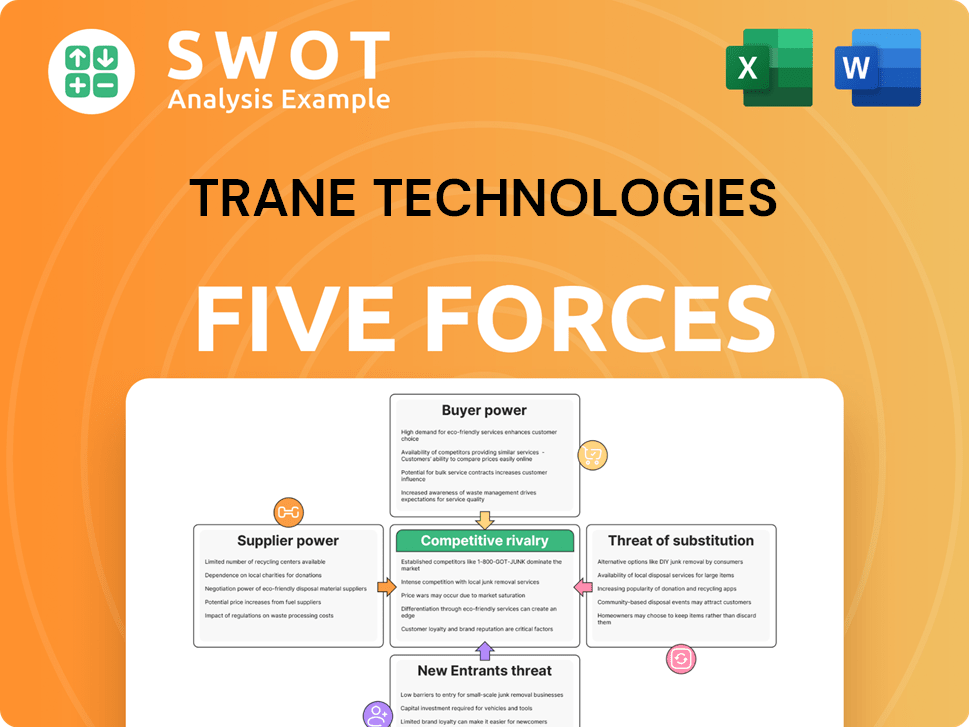
Related Blogs
- What are Mission Vision & Core Values of Trane Technologies Company?
- What is Growth Strategy and Future Prospects of Trane Technologies Company?
- How Does Trane Technologies Company Work?
- What is Sales and Marketing Strategy of Trane Technologies Company?
- What is Brief History of Trane Technologies Company?
- Who Owns Trane Technologies Company?
- What is Customer Demographics and Target Market of Trane Technologies Company?
Disclaimer
All information, articles, and product details provided on this website are for general informational and educational purposes only. We do not claim any ownership over, nor do we intend to infringe upon, any trademarks, copyrights, logos, brand names, or other intellectual property mentioned or depicted on this site. Such intellectual property remains the property of its respective owners, and any references here are made solely for identification or informational purposes, without implying any affiliation, endorsement, or partnership.
We make no representations or warranties, express or implied, regarding the accuracy, completeness, or suitability of any content or products presented. Nothing on this website should be construed as legal, tax, investment, financial, medical, or other professional advice. In addition, no part of this site—including articles or product references—constitutes a solicitation, recommendation, endorsement, advertisement, or offer to buy or sell any securities, franchises, or other financial instruments, particularly in jurisdictions where such activity would be unlawful.
All content is of a general nature and may not address the specific circumstances of any individual or entity. It is not a substitute for professional advice or services. Any actions you take based on the information provided here are strictly at your own risk. You accept full responsibility for any decisions or outcomes arising from your use of this website and agree to release us from any liability in connection with your use of, or reliance upon, the content or products found herein.